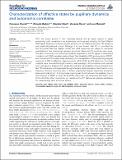Characterization of affective states by pupillary dynamics and autonomic correlates
Author(s)
Onorati, Francesco; Barbieri, Riccardo; Mauri, Maurizio; Russo, Vincenzo; Mainardi, Luca
DownloadOnorati-2013-Characterization of.pdf (1.177Mb)
PUBLISHER_POLICY
Publisher Policy
Article is made available in accordance with the publisher's policy and may be subject to US copyright law. Please refer to the publisher's site for terms of use.
Terms of use
Metadata
Show full item recordAbstract
With the recent advent of new recording devices and an easier access to signal processing tools, researchers are increasingly exploring and studying the Pupil Dilation (PD) signal. Recently, numerous studies pointed out the relations between PD dynamics and psychophysiological states. Although it is well known that PD is controlled by the Autonomic Nervous System (ANS), and ANS responses are related to emotional events/stimuli, the relationship between emotional states and PD is still an open issue. The aim of this study is to define the statistical properties of the PD signal, to understand its relation with ANS correlates such as Heart Rate Variability (HRV) and respiration (RESP), and to explore if PD could provide information for the evaluation of the psychophysiological response of ANS to affective triggering events. ECG, RESP, and PD data from 13 normal subjects were recorded during a memory recall paradigm, and processed with spectral and cross-spectral analysis. Our results demonstrate that variability indices extracted from fast PD oscillations, not observable through standard cardiorespiratory identification in the frequency domain, would be able to discern psychophysiological responses elicited by basic emotional stimuli. A strong linear coupling was found between the variables, due to the influence of RESP on both PD and HRV within the High Frequency (HF) band, from 0.15 to 0.45 Hz. Most importantly, our results point at PD features as possible candidates for characterizing basic emotional stimuli.
Date issued
2013-11Department
Massachusetts Institute of Technology. Department of Brain and Cognitive SciencesJournal
Frontiers in Neuroengineering
Publisher
Frontiers Research Foundation
Citation
Onorati, Francesco, Riccardo Barbieri, Maurizio Mauri, Vincenzo Russo, and Luca Mainardi. “Characterization of affective states by pupillary dynamics and autonomic correlates.” Frontiers in Neuroengineering 6 (2013).
Version: Final published version
ISSN
1662-6443